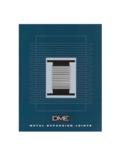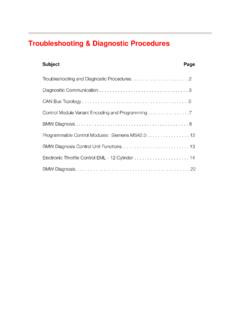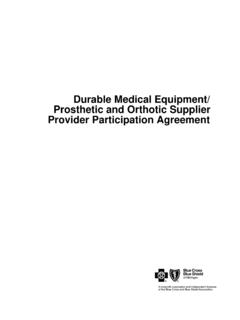Transcription of Table of Contents E65 BUS SYSTEMS - Xolmatic page
1 Initial Print Date: 10/01 Revision Date: 11/01 SubjectPageIntroduction.. 3 Bus SYSTEMS .. 3E65 Bus system Overview.. 6E65 Sub-Bus SYSTEMS .. 7 Gateways.. 10 Controller Area Network (CAN Bus)..16E65 K-CAN.. 16PT-CAN.. 20 Fiber-Optic Bus Lines..21 Fiber-Optic use in the E65.. 28 MOST Bus.. 31 Byteflight..45 Diagnosis Bus..49 Review Questions.. 51 Table of ContentsE65 BUS SYSTEMS2E65 Bus SystemsE65 BUS SYSTEMSM odel: E65 - 745iProduction Date: 11/2001- Start of Production Objectives:After completing this module you should be able to: Identify the various bus SYSTEMS used in the E65. Define the purpose of a Gateway module.
2 Describe the structure of the various bus SYSTEMS . Explain the purpose of Terminal Resistors in the CAN bus. Understand the reason why fiber-optic bus SYSTEMS are used in the E65. Describe how fiber-optic cables can be damaged due to improper SystemsIntroductionThe safety and comfort of vehicles are continually advancing. Legal requirements relating tofuel consumption and exhaust emissions can now only be met by the use of more elec-tronic components ( control units, actuators and sensors) in controlled by individual control units are increasingly being linked to one anoth-er via bus SYSTEMS . That means that the processes are shared together and control unitsinteract with one another in a coordinated a result, the exchange of data across the vehicle's electrical system is increasing rapid-ly and because of that exchange of information, many new functions are being madepossible.
3 The consequences of this trend are greater vehicle safety,superior ride comfort and improved fuel economy. However, such continuing advances canno longer be achieved with conventional electrical of Conventional Electrical SYSTEMS The increasing amount of desirable electronic components in cars is limited by a numberof factors. These factors include: Increasing complexity of wiring SYSTEMS Higher production costs Increasing demands on available space in the vehicle Extreme complexity of component configuration Reduced reliability of the overall systemIn order to minimize such disadvantages, bus SYSTEMS are now being used for the vehicle'selectrical systemsBus SYSTEMS enable the individual control units on the vehicle to be networked with oneanother via "serial interfaces.
4 " The use of bus SYSTEMS in vehicle electrical SYSTEMS providesa number of Bus SystemsAdvantages of Bus SYSTEMS Greater reliability of the overall system Simplification of wiring SYSTEMS Reduction of the number of separate cables Reduction of the cross-sectional areas of wiring looms Greater versatility in terms of cable routing Multiple use of sensors in the vehicle, thereby reducing the number of duplicated sensors Use of shared interfaces by signals, thereby reducing the number of interfaces Transmission of complex data Greater flexibility in the event of system modifications Data volume can be expanded at any time Flexible configuration of control units Adoption of new functions for customers Efficient diagnosis Lower hardware costsThe E65 introduces three (3) new bus SYSTEMS .
5 Two of them are based on fiber-optic tech-nology. The two new fiber-optic bus SYSTEMS are called:MOST bus(Media Orientated system Transport) and " byteflight"(safety SYSTEMS bus).The third bus system consists of two insulated copper twisted-pair wires and is called the:K-CAN(Body-Controller Area Network). The K-CAN bus replaces the single wire K bus(body bus) and is subdivided into two sections: the K-CAN system and the powertrain control units continue to use a CAN bus called the PT-CAN,except thatnow it is a three wire bus to include a KL-15 wake-up wire. Comparison of E38 and E65 bus systemsE38E65 CANPT-CANI-BusK-BusK-CAN SystemP-BusK-CAN Periphery-------MOST Bus-------byteflightD-BusD-bus5E65 Bus SystemsBus Communication SpeedsThe communication speed of the busses in the E65 have been increased significantly tohandle the demand placed on them by a greater number of control is a comparison between the busses of the E38 and the RateStructureE38I/K/P Bus SystemsE65 BUS SYSTEMKT-73237E65 Bus SystemsE65 Sub-Bus SystemsIn addition to the bus SYSTEMS , sub-bus SYSTEMS are also used.
6 These are subordinate ser-ial bus SYSTEMS . Their functions correspond to those of the previous I/K bus. The following sub-bus SYSTEMS are fitted on the E65: Driver's door P bus (driver's door switch block periphery bus) Engine LoCAN (engine Low CAN bus; link between DME and Valvetronic control unit) Telcommander CAN (Phone board CAN) M bus (air-conditioning motor bus) DWA K bus (alarm system body bus) BSD interface (bit-serial data interface)Driver s Door P-BusThe driver's door P bus passes the signals from the driver's-door switch block to the doormodule ( functions window lift, child lock-out request, Sun shade).
7 KT-7327P-Bus8E65 Bus SystemsEngine LoCANThe Engine LoCAN enables communication between the DME and the Valvetronic CANThe TelCommander CAN provides the link to the telephone control panel module. It is atwo-wire Bus SystemsM-BusThe M bus enables control of the various motors for the air conditioning K-BusThe functions of the alarm system are split between the two control units (DWA and SINE).The alarm system K bus enables communication between those two control Bus SystemsBSDC ommunication via the BSD enables adjustment of the battery charging voltage, and com-munication between the DME and oil quality sensor for gateway (GW) is an interface.
8 It connects different bus SYSTEMS within the vehicle's elec-trical system . It provides a means of ensuring the exchange of information in spite of differences in the rates of data transmission on the individual bus SYSTEMS . Diagnosticaccess to the individual control units from a central point is made possible by the gateway modules used in the E65 are the Car Access system (CAS), control Display(MCGW-MOST/CAN gateway) and the Central Gateway Module (ZGM).Method of OperationThe data transmitted by the various bus SYSTEMS is received by the gateway. At this point,transmission rates, data and priority levels of the individual messages are filtered and tem-porarily stored if necessary.
9 This requires a non-volatile Bus SystemsUsing gateway rules and conversion tables, the gateway converts the messages asrequired by the various bus SYSTEMS concerned. The messages are then passed to the var-ious bus SYSTEMS via which they reach their ultimate destinations (recipient control unit). Ifnecessary, messages that are relatively less important are held in the gateway's memoryand sent wake-upKT-8136 Overview of E65 gatewaysKT-829312E65 Bus SystemsExamples of the Function of the Central Gateway Module (ZGM)The DME and DSC control units both place mes-sages on the PT-CAN. Those messages arereceived by the Central Gateway Module fromthe PT-CAN.
10 The buffer memory on the CentralGateway Module temporarily stores the mes-sages from the are converted by the Central GatewayModule according to specific gateway rules andconversion tables for the K-CAN system the K-CAN system Bus is slower than the PT-CAN, the two messages are joined together and are sent out as one message. The mes-sages reach their destinations (IHKA/Kombi) via the K-CAN system Fuel Pump ControlThe DME calculates the delivery rate of fuel required on the basis of the vehicle's operatingstatus. The figure calculated is sent in the form of a message to the SBSR (right B-pillarsatellite).








